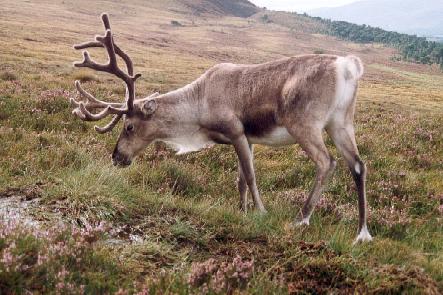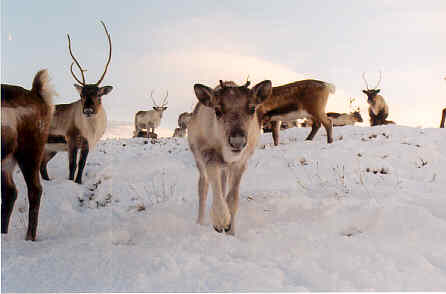|
|
Canku Ota |
|
|
(Many Paths) |
||
|
An Online Newsletter Celebrating Native America |
||
|
June 1, 2002 - Issue 62 |
||
|
|
||
|
Memories of a Reindeer Herder - Jimmy Komeak - Part Two |
||
|
|
|
The following six reindeer herders were interviewed: David Roland of Inuvik, Colin Harry of Aklavik, and Donald Pingo Sr., Stanley Keevik, Joseph Avik, Jimmy Komeak, all of Tuktoyaktuk. Adam Emaghok of Tuktoyaktuk was also supposed to be here, but was out of town and unable to return for the interview. The herders that were interviewed were selected following consultations with Herbert Felix of the EIRB, Frank Pokiak and Max Kotokak Sr. of the Tuktoyaktuk Hunters and Trappers Committee and Duane Smith of the Inuvialuit Game Council. Prior to the interview, questions were prepared by Linda Graf, EIRB Secretary, Dr. Robert White, EIRB Technical Advisor for the Kunnek Review and the author. All the herders were asked the standard list of questions by Marjorie Ovayuak of Tuktoyaktuk. The author recorded answers and provided clarification on the intent of the questions when necessary. Herders were not asked some questions if the author felt the answer to the question had been provided in previous answer(s). Maps and stickers were used to record the locations referred to during the interviews. Interviews were conducted from May 10-15, 2000. Fred Wolki of Tuktoyaktuk translated when necessary during the interview with Joseph Avik. Statements that appear in this report are not verbatim and are referenced according to the herder's initials, e.g. a statement made by David Roland would appear as DR. Statements made by Donald Pingo Sr., Stanley Keevik, Joseph Avik, and Jimmy Komeak were verified as accurate from July 18-19, 2000. David Roland and Colin Harry were not available to verify information in this report and their statements are, to the best of the author's recollection, what was reported at the interview. Prior to presenting the results from the interviews it would be helpful to provide background about the history of reindeer herding in the area. According to Treude (1975) and KRDC (2000), the reindeer have been owned and operated by various organizations, including:
Other aboriginal-operated herds existed in the 1940s and 1950s, but they are not discussed here since none of the herders that were interviewed worked with them. QUESTION: When were you a herder?
QUESTION: Where did you herd? The approximate locations of herding operations for the various owners are summarized below. In the 1940s and 1950s, the government of Canada's main winter operation was based out on Reindeer Station, and summer grazing occurred on Richards Island. During the existence of small aboriginal-operated herds in the 1950s, each aboriginal-operator was assigned an area for reindeer herding. The spring, summer and fall ranges for these herds were on the Tuktoyaktuk Peninsula. In the winter Adam Emaghok's herd was moved south to the Parsons Lake area and Joseph Avik and Jimmy Komeak's herds were moved southeast across Husky Lakes. Herding operations were shifted to the Tuktoyaktuk Peninsula when Silas Kangegana took over the herd. The herd spent summers grazing on the peninsula, northeast of Tuktoyaktuk and moved southwest to the area around Parsons Lake in the winter. QUESTION: How big was the herd you worked with and at any given time what was the area covered by that herd? Most of those interviewed found it difficult to quantify the area covered by reindeer. It was estimated that when brought together a herd of 4,000-6,000 reindeer would cover an area ranging from less than one mile to four miles. One herder indicated that when grazing the reindeer tended to spread out forming small feeding groups and hence covered a much larger area. One herder was not sure how big an area would be covered by a herd of 4,000 reindeer, but he remembered watching that many reindeer with binoculars.
QUESTION: What method of transportation did you use for herding in spring, summer, fall, and winter? Winter: In early years, skis were the primary mode of transportation, but dog teams were also used. Sleds with reindeer or dogs were used to transport materials. The CWS used snowmobiles beginning in the late 1960s, and snowmobiles were also used subsequently by Silas Kangegana. Summer: Herders always walked with the reindeer. The Government of Canada and Silas Kangegana used boats to position herders, and herders working for Silas Kangegana used canoes during roundup. Aircraft: When the herd was owned by Silas Kangegana, planes and helicopters were used occasionally for surveillance in the summer, for retrieving strays and for reconnaissance and positioning prior to roundup. Herd dogs: Herd dogs were used by the herders who worked for the Government of Canada, Joseph Avik, Adam Emaghok, Jimmy Komeak, the Canadian Wildlife Service and Silas Kangegana. The number of dogs used varied, but the herders working for the Government of Canada used as many as one dog per herder.
Government of Canada: Daily surveillance in fall, winter, spring, and early summer. After roundup in July or August, reindeer were left to roam Richards Island and herder presence was reduced to occasional surveillance. When the herd was under daily surveillance, nine to 16 herders were employed, two to five herders worked four-to five-day shifts, and time actually spent with the herd varied according to circumstance. Adam Emaghok: Daily surveillance in winter and spring, but in July the reindeer were let go and free to roam. Four herders were employed. Jimmy Komeak: Daily surveillance was necessary to prevent mixing with other aboriginal-operated herds in the 1950s. Four herders were employed throughout most of the year, and an additional person was hired during fawning. Joseph Avik There was daily surveillance. Four herders were employed and there were two herders per shift. CWS: 24-hour surveillance during fawning, but other times they would circle the herd once a day. Four herders worked seven days and then had seven days off. Silas Kangegana: During winter and fawning, three herders checked the herd twice daily to protect the herd from predators. From July to November, there was occasional surveillance by aircraft, but otherwise the reindeer were allowed to roam free on the Tuktoyaktuk Peninsula. In total, four herders were employed.
According to the herders, control of the herd varied. The following are some of the things that triggered straying:
When straying occurred, it took one to four days to retrieve the reindeer depending on how far they went and how the herders were traveling. If the herders were traveling on skidoo, they would usually retrieve the reindeer within one day. One herder said that when the herd was operated by the Government of Canada, all stray reindeer were retrieved, even if it was only one animal. One herder indicated to help maintain control of the herd, bells were placed on some of the reindeer and the herders could tell if the herd was "restless" if the bells were heard frequently. To help ensure that strays were detected, one herder said they used to circle the herd looking for tracks of reindeer that left the group and for tracks of predators that approached the herd. They also counted the number of marked reindeer in the group to see if it was the same number that were supposed to be there. |
|||||||||||||||||||||||||||||||||||||||||||||||||||||||||||||||||||||||||||||
|
|
||
|
|
||
| Canku Ota is a free Newsletter celebrating Native America, its traditions and accomplishments . We do not provide subscriber or visitor names to anyone. Some articles presented in Canku Ota may contain copyright material. We have received appropriate permissions for republishing any articles. Material appearing here is distributed without profit or monetary gain to those who have expressed an interest. This is in accordance with Title 17 U.S.C. Section 107. | ||
|
Canku Ota is a copyright © 2000, 2001, 2002, 2003 of Vicki Lockard and Paul Barry. |
||
 |
 |
|
|
The "Canku Ota - A Newsletter Celebrating Native America" web site and its design is the |
||
|
Copyright © 1999, 2000, 2001, 2002, 2003 of Paul C. Barry. |
||
|
All Rights Reserved. |
||
 As
a part of the environmental review of Kunnek Resource Development
Corporation's (KRDC) development known as "Revitalization of
the Western Arctic Reindeer Herd", the Environmental Impact
Review Board (EIRB) sought information about reindeer herding techniques.
This report summarizes the results of interviews with residents
of Tuktoyaktuk, Inuvik, and Aklavik who had experience herding reindeer
in the Western Arctic.
As
a part of the environmental review of Kunnek Resource Development
Corporation's (KRDC) development known as "Revitalization of
the Western Arctic Reindeer Herd", the Environmental Impact
Review Board (EIRB) sought information about reindeer herding techniques.
This report summarizes the results of interviews with residents
of Tuktoyaktuk, Inuvik, and Aklavik who had experience herding reindeer
in the Western Arctic. QUESTION:
How often were you with the herd?
QUESTION:
How often were you with the herd? QUESTION:
How easy was it to control the location of the herd? Explain some
of the difficulties you encountered?
QUESTION:
How easy was it to control the location of the herd? Explain some
of the difficulties you encountered?